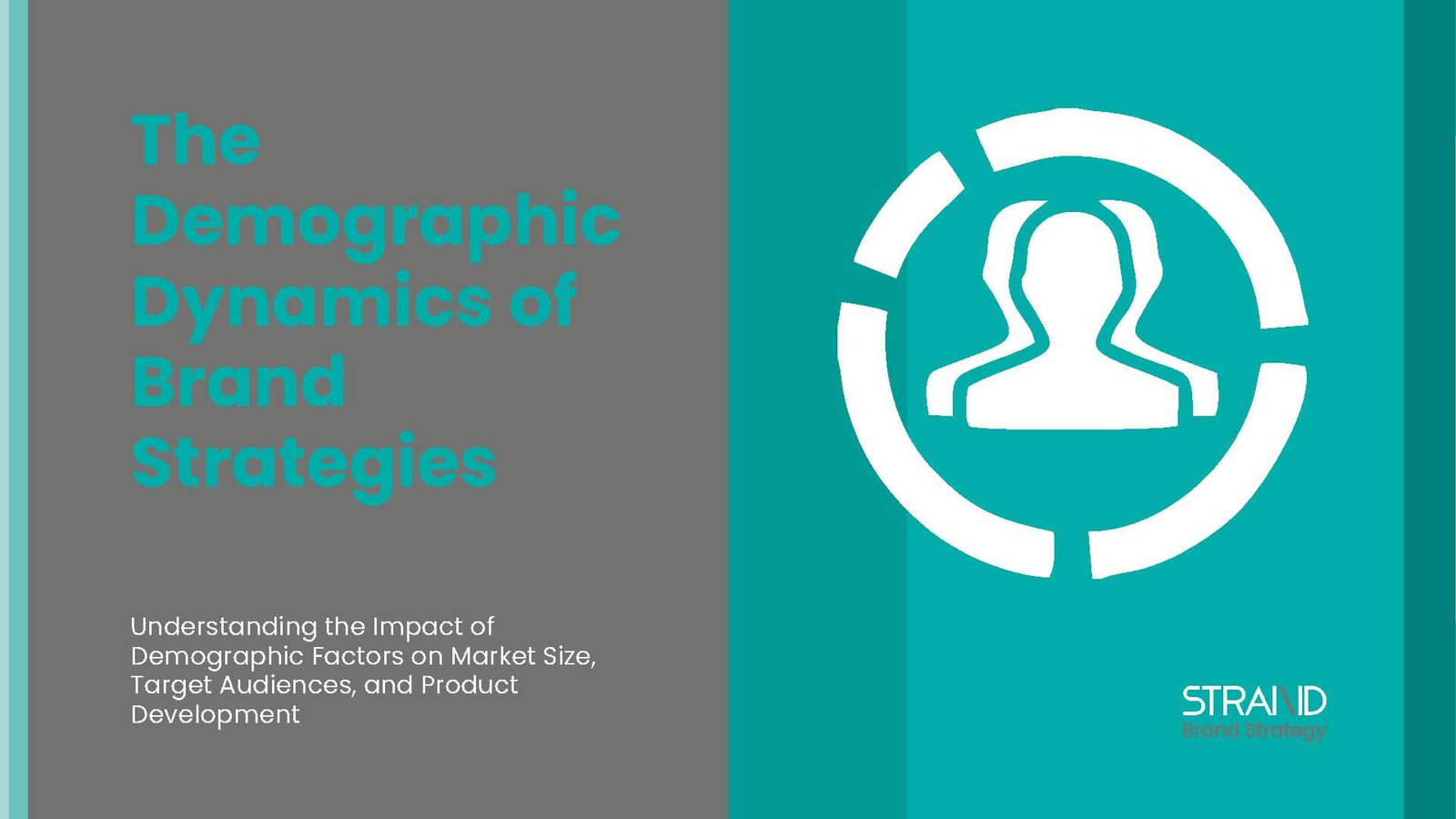The Demographic Dynamics of Brand Strategies
7 minutes | 26 Nov 2024Understanding the Impact of Demographic Factors on Market Size, Target Audiences, and Product Development
Demographics play a pivotal role in shaping market landscapes and influencing business strategies. Key demographic factors such as population growth, age distribution, education levels, and income inequality significantly impact market size, target audiences, and product development. By understanding these demographic trends, businesses can make informed decisions, tailor their offerings to meet the needs of diverse consumer groups, and capitalize on emerging opportunities.
In this article, we will explore how demographic shifts affect business strategies and market dynamics, and how companies can leverage this knowledge to stay ahead of the curve and drive sustainable growth.
Population Growth and Market Size
Population growth refers to the increase in the number of people living in a specific area over time. It is a critical factor influencing market size, as a growing population expands the potential customer base for businesses. Population growth can be driven by various factors, including birth rates, immigration, and changes in mortality rates.
Global population growth has been uneven, with some regions experiencing rapid increases while others face stagnation or decline. According to the United Nations, the world population is expected to reach approximately 9.7 billion by 2050, with significant growth concentrated in regions such as sub-Saharan Africa and South Asia.
In developed countries, where population growth is slower, businesses may focus on strategies to cater to an aging population and a more mature market. In contrast, emerging markets with high population growth offer opportunities for businesses to tap into expanding consumer bases and explore new market segments.
Population growth directly impacts market size, as a larger population generally leads to increased demand for goods and services. Businesses operating in rapidly growing regions may experience higher growth potential and increased sales opportunities. However, they must also navigate challenges such as infrastructure development, resource allocation, and competition.
Companies like Unilever and Nestlé have successfully tapped into the growing populations in emerging markets by expanding their product offerings and distribution networks. Their strategies include developing affordable products tailored to local needs and investing in supply chain improvements to reach new consumers.
In contrast, businesses in regions with stagnant or declining populations, such as Japan and parts of Europe, may face challenges related to market saturation and declining consumer spending. Companies in these markets often focus on innovation, premium products, and enhancing customer experiences to maintain growth.
Age Distribution and Target Audiences
Age distribution refers to the proportion of different age groups within a population. It influences consumer preferences, spending habits, and product demand. Understanding age distribution helps businesses identify target audiences and tailor their marketing strategies to appeal to specific age groups.
- Youthful Populations:
In regions with a large proportion of young people, businesses may focus on products and services that cater to youthful tastes and preferences. This demographic often drives trends in technology, entertainment, and fashion. Companies targeting younger consumers may invest in digital marketing, social media, and innovative product features. - Aging Populations:
In countries with aging populations, businesses may focus on products and services that address the needs of older adults, such as healthcare, retirement planning, and senior-friendly technologies. Companies in these markets may also invest in accessibility features and customer service tailored to older consumers.
Different age groups have distinct preferences and needs, requiring businesses to segment their target markets effectively. Companies must adapt their product offerings and marketing strategies to align with the characteristics of each age group. For instance, while younger consumers may be attracted to tech-savvy products and trends, older consumers may prioritize reliability and ease of use.
Understanding age distribution helps businesses engage effectively with diverse consumer groups, ensuring that their products and marketing strategies resonate with target audiences. This knowledge also aids in product development, pricing strategies, and promotional efforts.
Apple’s product development strategy reflects its focus on younger consumers through its emphasis on innovation, design, and technology. The company’s marketing campaigns often highlight cutting-edge features and creative applications of its products, appealing to tech-savvy youth.
Conversely, companies like Philips and Johnson & Johnson have tailored their product offerings to address the needs of aging populations. Philips’ healthcare products and Johnson & Johnson’s personal care items cater to the requirements of older adults, emphasizing health, safety, and ease of use.
Education Levels and Product Development
Education levels within a population influence consumer behavior, purchasing power, and demand for specific products and services. Businesses can leverage this information to develop products that align with the educational background and skills of their target audiences.
- Higher Education Levels:
In regions with higher levels of education, consumers are often more informed and discerning. They may prioritize quality, innovation, and sustainability in their purchasing decisions. Businesses targeting educated consumers may focus on premium products, advanced technologies, and ethical practices. - Lower Education Levels:
In areas with lower education levels, businesses may need to emphasize affordability, practicality, and ease of use. Products that offer clear benefits and straightforward functionality are more likely to resonate with consumers in these markets.
Education levels can impact product demand and market segmentation. Businesses must consider the educational background of their target audiences when designing products, developing marketing strategies, and setting pricing. Companies that invest in consumer education and provide accessible information can enhance brand loyalty and drive sales.
Education levels influence consumer expectations and product requirements. Businesses that align their offerings with the educational background of their target markets can build stronger connections with consumers and address their specific needs more effectively.
Tesla’s emphasis on innovation and advanced technology reflects its focus on educated consumers who value cutting-edge solutions and environmental sustainability. The company’s marketing highlights the benefits of electric vehicles and renewable energy, appealing to tech-savvy and environmentally conscious individuals.
In contrast, companies like Procter & Gamble focus on practical, affordable solutions that address everyday needs. Their products are designed to be accessible and user-friendly, catering to a broad range of consumers with varying educational backgrounds.
Income Inequality and Market Segmentation
Income inequality refers to the uneven distribution of income within a population. It affects consumer purchasing power, market demand, and product accessibility. Understanding income inequality helps businesses segment their markets and develop products that cater to different income levels.
- Affluent Consumers:
In markets with significant income inequality, affluent consumers may drive demand for luxury goods, premium services, and high-end experiences. Businesses targeting this segment may focus on exclusivity, quality, and personalized service. - Low-Income Consumers:
For low-income consumers, businesses may emphasize affordability, value, and practicality. Products and services that offer cost-effective solutions and essential features are more likely to resonate with this demographic.
Income inequality presents both challenges and opportunities for businesses. Companies must navigate the complexities of serving diverse income groups while addressing issues of affordability and accessibility. By developing tiered product offerings and flexible pricing strategies, businesses can cater to various income segments and expand their market reach.
Addressing income inequality involves understanding the diverse needs of different consumer segments and ensuring that products and services are accessible to a broad audience. Businesses that adopt inclusive pricing and product strategies can enhance their market presence and contribute to social equity.
Luxury brands like Louis Vuitton and Rolex cater to affluent consumers by offering high-end products and exclusive experiences. Their marketing strategies emphasize prestige and craftsmanship, appealing to high-income individuals.
Conversely, companies like Walmart and Aldi focus on providing affordable products and value for money. Their business models are designed to serve low-income consumers by offering cost-effective solutions and accessible pricing.
Leveraging Demographic Insights for Strategic Success
Demographic factors such as population growth, age distribution, education levels, and income inequality play a crucial role in shaping market dynamics and influencing business strategies. By understanding these factors, businesses can make informed decisions, tailor their product offerings, and develop targeted marketing strategies that resonate with diverse consumer groups.
Embracing demographic insights allows companies to adapt to changing market conditions, address the needs of different audiences, and capitalize on emerging opportunities. As demographics continue to evolve, businesses that stay attuned to these trends and adjust their strategies accordingly will be better positioned for long-term success and growth.

